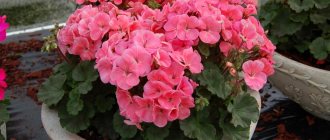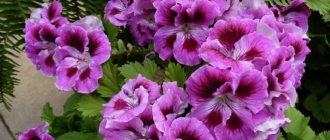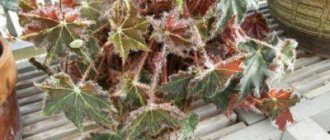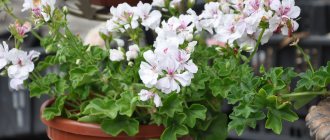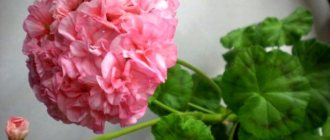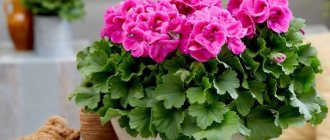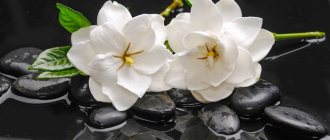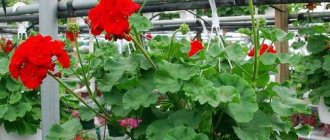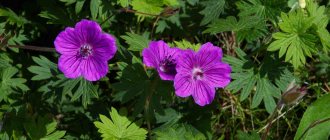Royal geranium is the fruit of many years of painstaking work by breeders. It differs from other similar varieties in its delicate delicate aroma and large size of flowers, which form a cap above the green leaves. It is also known as Grandiflora. This plant looks simply gorgeous; every gardener dreams of having such a luxurious beauty. However, it is worth remembering that large-flowered royal geranium is very capricious and difficult to care for.
This variety of pelargonium has not only an interesting history, but also a number of distinctive features by which it can be easily recognized.
Royal geranium is very difficult to grow, but its chic appearance and delicate delicate aroma compensate for all the inconvenience and costs
It got its name due to its chic appearance during the flowering period. However, in order to achieve the desired result, you need to put in a lot of effort.
Description of royal geranium
Royal pelargonium is considered one of the beautiful flower hybrids. The Cape region, located in southwest Africa, is considered to be its homeland. The height of the bush does not exceed 50 cm, while the flowers are located at the level of the foliage.
The inflorescences can reach 15 cm in diameter. The color varies from white to dark, similar to black. There is mainly a palette of scarlet shades. The petals are arranged in two, sometimes three rows. The upper one is distinguished by a bright, rich hue, often with a spotted pattern or veins. Externally similar to pansies.
The leaves are dense, velvety, with wavy edges, sometimes with small teeth. Arranged alternately on the cuttings. Color green. The stem is straight, latent. The root system consists of adventitious roots.
Candy Flowers
Varieties and types of royal geranium
Scientists from Germany have bred more than a thousand varieties. The most common types among gardeners are two: Candy Flowers and Angels. Both have lush flowering and are easy to care for.
| View | Description | Application | Varieties, inflorescences |
| Candy Flowers | Selective hybrid of pelargonium with the Angels variety. | Planted in open ground, similar to the parent group (Angels) in terms of growing and maintenance conditions, does not require wintering, blooms even in extreme heat. | It is distinguished by large flowers.
|
| Angels | They do not have a wintering period, they bloom magnificently, but for a short time (one month - August), in some varieties the foliage has a rich aroma, thanks to the participation of curly pelargonium in the hybridization of the variety. The storage of the trunk allows you to give the bush an ampelous appearance. | Used in breeding the Candy Flowers species. | Small flowers on a low stem, similar to pansies.
|
Angels
Plant nutrition
The flower needs abundant watering, but in addition to watering, it is important to feed the “ball”. How can you feed the plant so that it pleases you with flowers? For abundant flowering in the garden, geraniums are watered with fermented mullein.
On the balcony and windowsill, to stimulate flowering, the plant is watered with water with the addition of iodine. Dissolve one drop of iodine in one liter of water and water the plant with 50 grams of iodine water along the walls of the flowerpot. Before fertilizing with iodine, water the flower abundantly so as not to burn the roots. This procedure is carried out once a month.
As a fertilizer for geranium, you can use other products purchased at the pharmacy. In addition to iodine, flower growers use vitamins B1, B6, B12. This is an inexpensive folk method.
With the beginning of spring, geranium needs nitrogen. For summer, vitamins are used - one ampoule per 2 liters of warm water. The soil is watered generously with the solution. After 3 weeks, vitamins are changed. This fertilizer will help royal geranium, but you should not overdo it with fertilizing, as this can destroy the plant.
Organic fertilizers should be used with caution. For lush color, water with well-fermented cow manure (per 10 liters of water - 1 liter of manure), bird droppings (per 20 liters - 1 liter). Fresh manure can destroy the plant.
When choosing between mullein and chicken droppings, it is better to use the first option. For lush flowering, minerals are needed, so organic matter is rarely used.
Unusual varieties of royal geraniums
Among the hybrids, scientists managed to obtain varieties with an unusual structure and bright colorful flowers.
| Variety | Flowers | Peculiarities |
| Sally Munro | The top is rich red, the bottom is pale pink. | They bloom several times per season. |
| Mona Lisa | White. | It stands out for its lush flowering among varieties with snow-colored flowers. |
| Georgina Blythe | Orange with a scarlet tint, whitish wavy edges and a center. | Does not exceed 35 cm in height. |
| Morwenna | Rich dark burgundy shade. | The tone is close to black. |
Basic rules for home care
Royal geraniums at home require special care. The gardener should make an effort to ensure that the flower grows and blooms.
| Factor | Conditions | |
| Spring Summer | Winter | |
| Location | Place it on the windowsill on the sunny side. | Place in a cool place, away from heating appliances. |
| Temperature | +20…+25 °C | +17…+19 °C |
| Lighting | Avoid exposure to direct sunlight. In this case, the plant is shaded. | Use phytolamps for additional light. |
| Humidity | Increased, depends on the temperature of the room. In dry air, spraying can be used, but not excessively. | |
| Pot | Choose narrow and shallow. Royal geranium loves cramped spaces and does not tolerate frequent transplants. Material: unglazed ceramics. | |
| Watering | Twice a day, 50 ml/time per plant, through a tray. The water is settled and kept in the same room as the flower so that its temperature corresponds to room temperature. Use boiled, rain water. Do not spray. | Reduce, water once a day when the top layer of the earthen clod dries. |
| Top dressing | Mineral once a week, 2-3 months before flowering, they begin to add fertilizers, including phosphorus and potassium. For young people, special complexes are used. It is not recommended to resort to organics. | Does not require additional feeding. |
| Trimming | They don't. | It is carried out after the end of flowering, in the fall, in two stages, the interval between them is 45-50 days. |
Pests
- Aphid.
- Ticks.
- Termites.
- Caterpillars.
- Whiteflies.
Various insecticidal preparations are used to control pests . Aspirin will also help. To do this, an aspirin tablet is dissolved in 8 liters of water and the plant is treated with this solution. This treatment must be done once every three weeks.
So you have become acquainted with the basic rules for caring for royal pelargonium. She is, of course, more finicky in care than her other relatives, but her luxurious appearance will not leave you indifferent despite the slight difficulties in caring for her.
Royal pelargonium is a luxurious flower that can attract the attention of anyone. And the gardener’s desire to increase the number of copies of this plant in his home is absolutely understandable. Read our materials on how to propagate and why royal pelargonium does not bloom.
Features of summer care at home
Pelargonium blooms in summer. The flower only needs watering and feeding. If he is in the fresh air, then carefully monitor the temperature. At values below +22...+24 °C, watering is reduced, below +10 °C, and the uniformity of drying of the earthen clod is regularly checked. Excessive moisture can cause root rot and mold growth. It is recommended to water in the early morning before the heat sets in or in the evening, when the sun no longer shines and goes into sunset.
For feeding, fertilizers with minimal or no nitrogen content are used.
On the street, pelargonium is constantly checked for pests. When they are detected, they are immediately treated with an insecticide so that the plant does not get sick or die. When choosing a location, avoid direct light.
The sun's rays may leave burn marks on the foliage or it will change color to scarlet. Royal geranium does not tolerate changing places well, so it is advised not to plant it in open ground or to do it together with a pot to preserve the rhizome from insect attacks.
How to store in winter
For most pelargoniums, in October, with the arrival of cold weather, a period of dormancy begins. No, the plant does not shed its leaves, it simply stops blooming and slows down in growth.
At this time, stop feeding, and the flower should be kept in a room with a temperature of +12 to +15 ⁰C. If necessary, additional lighting is installed so that the stem does not stretch too much.
Landing of a royal beauty
Frequent transplants for Royal geraniums are a source of stress, so they are carried out only after the root system has completely filled the space in the pot.
The optimal time is the end of winter - the beginning of spring, before flowering. The dishes are chosen with a diameter 1.5-2 cm larger. Drainage is laid out at the bottom and covered with a layer of cotton fabric on top. This will help retain the soil. The substrate can be purchased at the store. It is necessary to ensure that it does not contain components that retain moisture. When preparing it yourself, use peat, humus and sand (1:1:1). To improve the quality and create a slightly alkaline environment, ash is added. The soil should be nutritious and loose in consistency.
If the flower was purchased in a store, then you need to wait until the end of flowering and give it time to adapt to the new place. Only then proceed to transplantation.
The process begins with abundant watering, then the plant, together with a damp earthen ball, is placed in a prepared container. The free space is filled with fresh soil.
Tips for Beginners
Many inexperienced gardeners are faced with the fact that royal geraniums do not bloom. This may be due to many reasons:
- plant damage by bacteria and fungi;
- errors in care;
- frequent transplants.
- First of all, you need to examine the pelargonium. If there is rot or dark spots on its green part, you need to clean the root system from the soil, rinse it under running water and immerse it in a weak solution of manganese for 2-3 days. The affected parts of the flower should be cut off or cleaned.
- The soil and pot must be doused with boiling water before planting.
After replanting the plant, you need to carefully monitor its condition.
Reproduction
Propagated in two ways: cuttings and seeds. The first is simpler, in the second case the flowering will be longer, the root system will be developed and strong.
Cuttings
For planting, use the top shoots 7-10 cm long with 2-3 nodes on each, obtained during spring pruning. Dry them for two hours after cutting.
The resulting material is planted in the soil, not placed in water, where it can rot and not take root. The soil for planting is prepared in advance. For this:
- prepare a mixture of perlite and earth (1:1);
- disinfect the resulting substrate in the oven or using a solution of potassium permanganate;
- leave it to stand for two days.
Before planting, the bottom of the shoot is sprinkled with Kornevin’s preparation, then it is planted in a prepared container and buried 2 cm into the soil. Leave in dim light and temperature +14…+16 °C. Water through a tray to prevent the roots from rotting from excess moisture.
The planted shoot takes root within a week, then it can be transplanted into a pot. When the shoots are planted in prepared soil, they are not covered with film, creating a greenhouse effect. To strengthen the rhizome, emerging leaves are cropped so that the plant does not waste its energy on them.
To simplify the procedure for planting cuttings, use a peat tablet. In this case, the tray with them is placed on the windowsill, protected from direct rays of the sun. Scald with boiled water, left for 3 days, for disinfection; after the moisture has been absorbed, the excess is drained. The cuttings are dipped in a root system growth accelerator; this condition is mandatory for Royal Pelargonium. Then the tablets are planted in the center and buried by one third. The substrate is pressed tightly to eliminate excess water. A greenhouse is not created, spraying is not carried out, this is contraindicated. After the roots appear, carefully make cuts on the sides with scissors and remove the tablet. Those places where the roots have grown into it are not touched. The seedlings are placed in plastic cups where they continue to grow.
Propagation by seeds
Reproduction material is purchased at the store. Sow at the end of February, before flowering begins. The substrate is prepared from peat and sand (1:1), ash is added. Disinfect by calcination or a solution of potassium permanganate. The seeds are small, elongated. They are buried 5 mm into the soil. The seedlings are covered with film, a greenhouse effect is created and placed in a warm place with bright, diffused light and a temperature of +21...+25 °C.
In a month the first shoots will appear. As soon as they have released two leaves, they are planted in separate pots with a diameter of 10 cm and a depth of 14 cm. A layer of drainage is laid on the bottom. After the 5th leaf appears, pinching begins to give it shape and get more side shoots to make the bush fuller.
What to do next
To get a new geranium bush at home, stock up on a suitable pot of not very large diameter. Place drainage at the bottom - clay shards that fill the pot in its lower part are suitable as drainage. A soil mixture consisting of equal amounts of sand and peat is placed on top, then everything is thoroughly watered.
After this, pre-prepared cuttings of royal pelargonium are planted. They should not be planted in too wet or, on the contrary, very dry soil. Immediately after the planting procedure, watering should be carried out only along the edges of the pot.
Mr. Summer Resident warns: possible problems when growing royal geraniums
Large-flowered geranium has its own nuances in care. If you do not follow them, you may encounter a flower disease or a change in appearance. It won't bloom.
| Problem | Cause | Elimination |
| The trunk is rotting (blackleg disease) | Low temperature, excessive or improper watering. | The plant and soil are affected and must be disposed of. The window sill and pot must be treated with chloride. |
| Mites, weevils, aphids, whiteflies | Infestation with parasites. | Wipe the back of the leaves with chamomile infusion and leave for a couple of hours, then rinse. If the decoction does not help, apply an insecticide. |
| No flowering | Low temperature, dry air, insufficient lighting, improper pruning, large pot volume, soil oversaturated with nutrients, nitrogen present, inappropriate fertilizer or lack thereof. | Correct deficiencies in care and create comfortable conditions. |
| The foliage is yellow, falls off, the stem grows, but does not bloom | Little light. | Add light using phytolamps. |
| Green, but lethargic, watery pads have formed. | Over-watering can lead to a disease - gray rot, then the affected foliage is removed and the plant is treated with drugs. | Reduce watering. |
| The ends turn yellow | Lack of moisture. | Increase the amount of moisture supplied. |
| Scarlet shade | Low temperature, drafts. | Move to a warm place with optimal performance. |
What difficulties may arise?
Even with a slight violation of the conditions of maintenance, the royal geranium may not bloom or shed already formed buds. In addition, the grower may encounter the following problems:
- if plants are taken out into the garden or onto the veranda in summer, they may begin to wither due to difficulties with acclimatization;
- even careful care of royal geranium is not able to make its flowering last as long as that of zonal varieties;
- propagating a flower by cuttings or seeds requires close attention and patience.
Only those who can please the bright beauty will be awarded large beautiful flowers:
- If the inflorescences fall off too quickly, this may be caused by excess nitrogen in the soil or dry air in the room.
- With proper care, geranium rarely gets sick, but from excessive watering or when using contaminated soil, the lower part of the plant stem is affected by rot. This pathology is called “black leg”. It is impossible to save the damaged areas; all that remains is to remove them.
- If the geranium leaves have dried out and turned yellow, it means that the crop does not have enough moisture, and if they have wilted, the frequency of watering should be reduced.
- The plant can be attacked by pests such as:
- spider mite;
aphid;
- whitefly
To get rid of them, you can spray geranium with chamomile infusion.
Royal pelargonium is a demanding plant . In order for the bush to develop properly, you need to take care of it responsibly. But the effort is worth it - geranium responds to care with abundant flowering.
